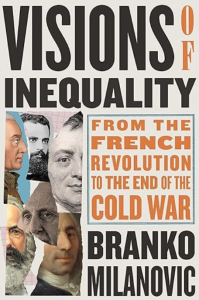I was very excited to get a proof copy of Branko Milanovic’s new book, Visions of Inequality From the French Revolution to the End of the Cold War, a while ago. The book is out in early October so it seems ok to post about it now. For anybody interested in inequality – and we all should be – anything by Milanovic is an essential read. His collation and interpretation of global inequality data is masterly, and his perspective from a socialist background (he was born in former Yugoslavia) is always interesting.
This new book is an intellectual history of how economists of the past have perceived and analysed inequality. The chapters cover Quesnay, Smith, Ricardo, Marx, Pareto, Kuznets and then – for the second half of the 20th century – a cluster of neoclassical economists during the period the book labels as ‘the long eclipse of inequality studies’. The Cold War involved in the west the myth (in economics although not in life) of a classless society. The book aims to describe each thinker’s ideas about the dynamics of income distribution, but not their normative perspective. Hence the discussion of Marx covers the evolution of wages and the downard tendency of the rate of profit but not the labour theory of value and alienation.
As I’m no expert on the history of thought, I learned a lot from the earlier chapters. The earlier thinkers all framed their analysis around the concept of social classes: “Classes were the natural concepts around which income distribution was ‘built’.” With Pareto, the analysis shifted to interpersonal distribution within a framework of the social hierarchy (the eltie vs the rest), and then with Kuznets and the later neoclassicals to individuals. This was partly driven by the availability of data on individual incomes from income tax records, after the introduction of direct taxation. The distribution among individuals could be sliced in different ways – location, education, occupation – but the background context of social structure faded. And then, after around 1960, economists’ interest in income distribution faded too. Why?
One comment Milanovic makes in the introduction struck home: “The puzzle was solved when I realized that the discipline of economics, as it was taught and studied betweem 1960 and 1990 in the West, was really designed for the period of the Cold War. …. Inequality seemed like a problem that was going away, and this reduced interest in studying it. … Each side [in the Cold War] had to insist that it was more equal and less class based than the other.” The book quotes Kuznets’ 1955 AEA Presidential Address calling for economists to begin to look at processes of long-term change – technology, demography, social frameworks: “Effective work in this field necessarily calls for a shift from market economics to political and social economy,” Kuznets said. Of course, this did not happen and economics doubled down on the market framework. “We might say that economics as a field stagnated or even regressed, at least in its understanding of income distribution under modern capitalism,” Milanovic comments.
This has changed in recent years, with the empirical work of economists like Milanovic, Saez and Piketty – I would add the prescient prior work of Tony Atkinson (Inequality: What Can Be Done is a terrific overview and battle cry), who was ahead of his time. Visions of Inequality ends with a call to augment the study of individual incomes with a greater focus on non-labour income, on household income rather than the individual wage earner, and on global inequality. My addendum would be the distribution of unpaid work within the household and the community. It’s an exciting time to be studying inequality thanks to the data and recent scholarship, and an important time given how unsustainable the current distribution has become – after all, the term ‘elite’ has become an insult in political debate. This book is a great scene setter for the modern debate, not least in illustrating the link between ideas of inequality and the times in which ideas are formed.


In the 60s-90s, inequality became seen as something that was traded off for growth. Income distribution was a secondary objective after economic growth, so economic theorists’ focus was on efficiency, and labor not immediately linked to generating income was devalued. Now that growth is saturating, and economic systems are breaking down because there aren’t enough people in critical but devalued jobs, we have more incentive for thinkers to focus again on inequality.